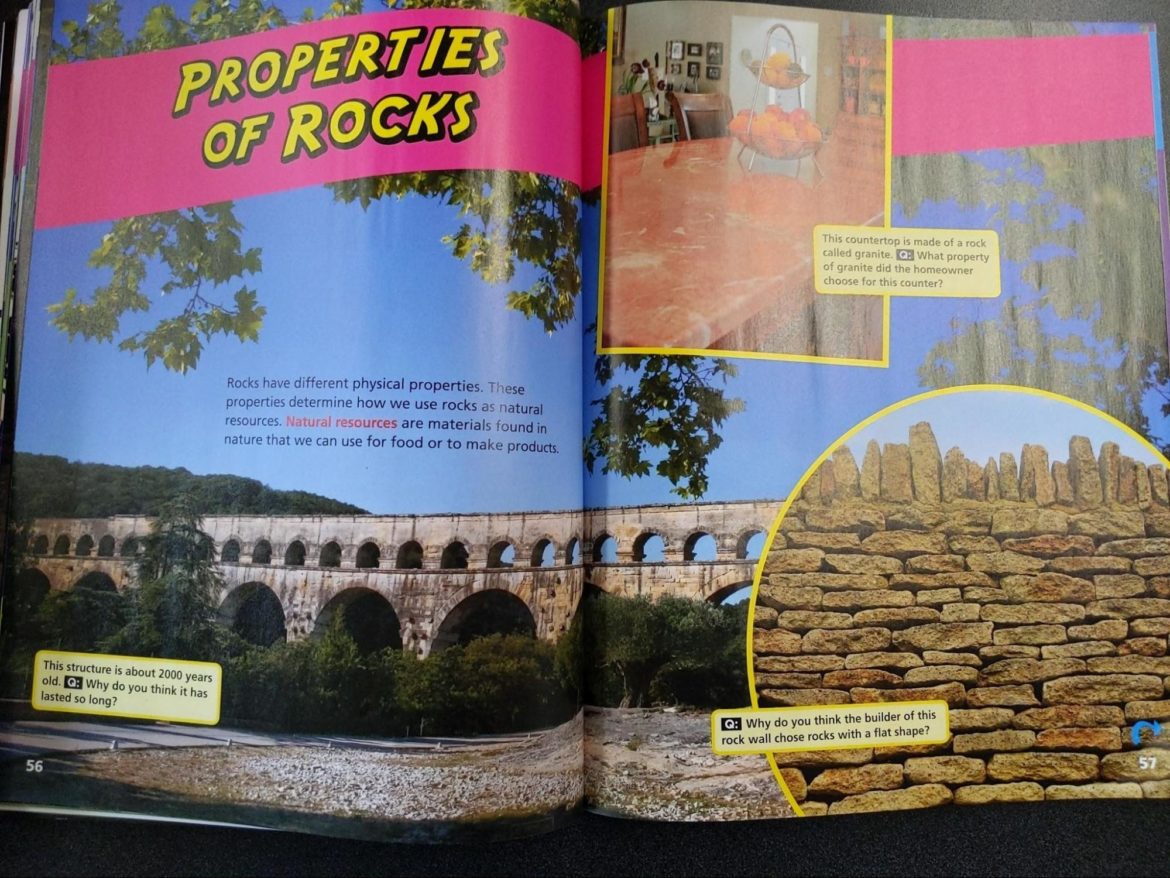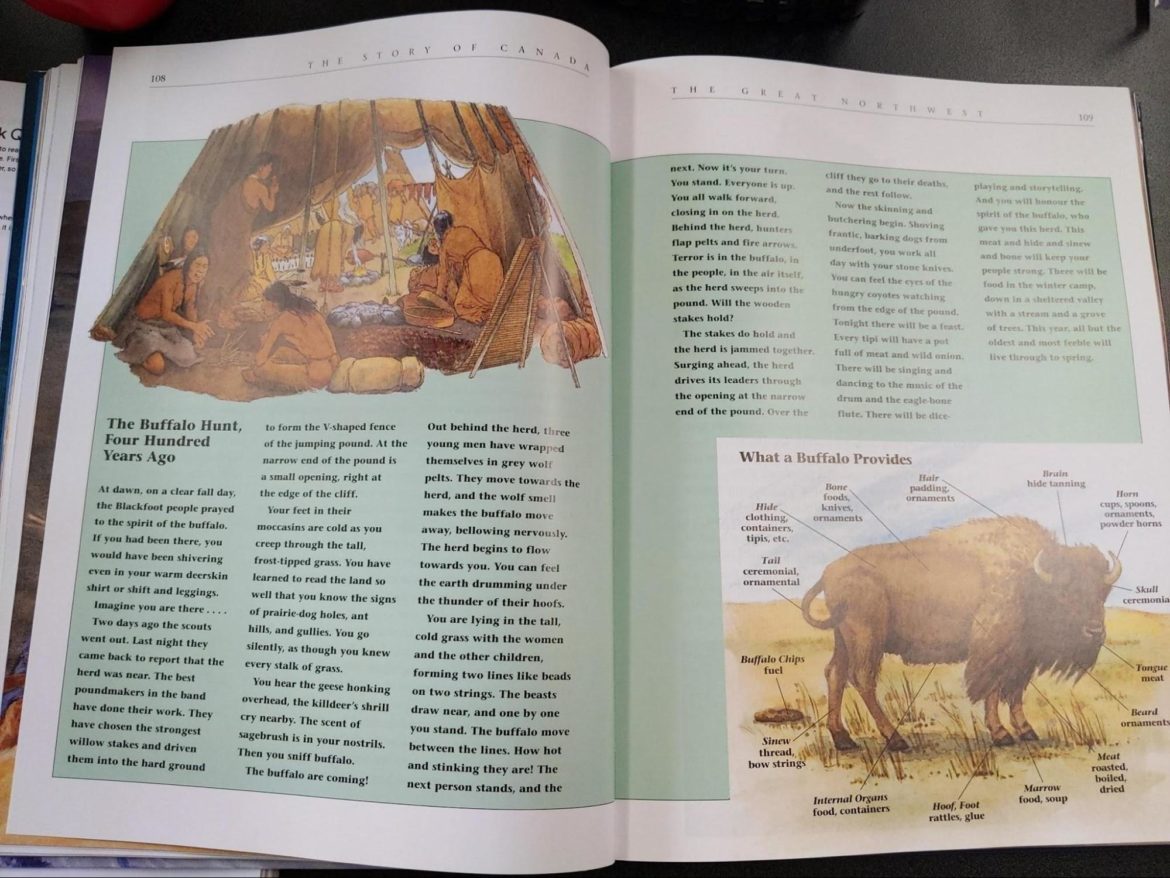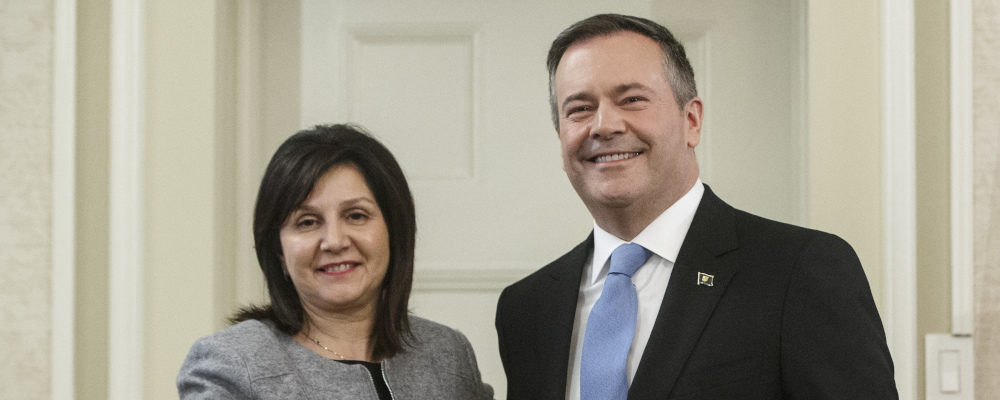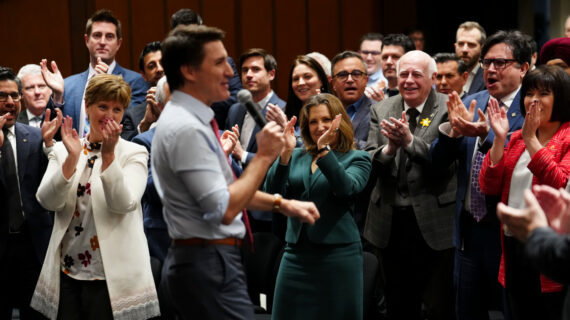The debate on the new draft curriculum for K-6 students in Alberta has provided Canadians with a window into an important issue in education. In a world characterized by easy access to information through the internet, how important is it for people to know things, and how important is it for schools to actually teach stuff?
After all, we have Google now, and Wikipedia too. All that one could want to know is available just a few clicks away, so why not use school to help kids inquire, explore, and discover? That sounds more fun, more democratic, more modern, and more like what kids will be doing when they get older and go onto jobs in the creative economy.
In my province of British Columbia, the education ministry has embraced this logic, and has come down quite firmly on the side that it’s not all that important that kids are taught information. The goal of our curriculum is instead is to form them in a mindset of inquiry, and then give them the opportunity to practice that mindset while developing skills and exploring their world.
MORE SIGNAL. LESS NOISE. THE HUB NEWSLETTER.
Knowledge and skills are still in the curriculum, but they have been de-emphasized in favour of this inquiry approach, so there is little clarity about exactly what knowledge and skills are to be taught in each grade. There is no “scope and sequence,” for example, which is what the previous generation of teachers would have called the clear list of which knowledge and skills should be introduced, developed, and mastered in each grade.
Instead we get “big ideas,” “core and curricular competencies,” and “sample topics” which teachers are expected to choose from and address throughout the school year.
The draft K-6 social studies curriculum in Alberta takes the opposite approach, encouraging teachers to explicitly teach a certain body of stories, facts, and skills to their students in a clear sequence. The idea here is that what you learn in one grade builds on what you learned in the previous grade, and that there is a clear progression towards a rich body of knowledge of contemporary Albertan society and the wider world.
The draft Alberta curriculum is clear in its intention that some skills should be mastered, not just practiced, and some information should simply be known by heart, not just touched on or explored. This has proven controversial, as its critics see it as an invitation to a bygone era of dull memorization and rote learning. To make it even worse, the curriculum actually lays out what knowledge and skills its writers see as core for today’s children, which inevitably invites more pushback on each individual topic or skill in a way that the less structured inquiry approach does not.
So which approach is better? British Columbia or Alberta? Inquiry or knowledge and skills? Well, the truth is that all of these have their place, and that both approaches are important for kids. Good B.C. teachers make sure that some core knowledge is learned and even memorized, and that certain skills are practiced and eventually mastered, even as they work within an inquiry framework.
The knowledge-rich approach is better supported by the cognitive science around how kids learn.
Likewise, if the draft curriculum is adopted, good Alberta teachers will encourage kids to think deeply, critically, and creatively as they learn about the topics they are studying. Having said that, my experience as a B.C. teacher leads me to believe that Albertan teachers, parents, and students should be grateful for the overall knowledge-rich approach of their draft curriculum, and to hope that policymakers west of the Rockies will pay attention to what their to peers east of them have been doing.
While individual topic selection can be quibbled with, and there is always room for improvement, the overall approach is a very good one, and is far better than the inquiry approach that B.C. has implemented. Why do I believe that? I have three main arguments supporting this perspective.
I should note here that discussions on education are often tough ones, as accusations of bad faith and harming children are thrown around all too easily. Debates on education policy are often quite brutal, and many have trouble accepting that those who disagree with the teachers unions’ view also care about children and have good reasons for what they believe. That’s part of what has held me back from contributing to this discussion to this point. But what kids learn and how they learn is important for all members of the community, and teachers who have been cowed into silence by the loudest and most strident voices need to speak up. That’s what I’m trying to do in this essay.
My first reason for supporting the knowledge-rich approach is that it’s better supported by the cognitive science around how kids learn. Take reading, for example. We know that reading has two basic components: decoding, which is the ability to recognize and sound out the words on a page, and comprehension, which is the ability to understand what they mean.
Decoding is an explicit skill that can be taught through phonics. It involves several discreet skills, including recognizing which sounds correspond to which letters, blending and combining them to make words, and then developing some automaticity with this, so that you do not have to sound out each individual word in front you.
The reading wars of the 1980s and 1990s — which pitted advocates of whole language teaching, or “picking it up” in reading, against those who wanted to teach phonics explicitly — have largely ended, and there is wide consensus that phonics skills are worth teaching to all children. The Alberta and B.C. curricula both mandate phonics for decoding in the younger grades.
How to teach comprehension is more hotly debated, and this is at the core of the difference in approach. Understanding individual words and phrases means knowing how they connect to other words and how they fit in to different contexts. You can change lines in a hockey game or say your lines in a play. But how do you develop such an understanding of different words?
Repeated exposure to high-quality vocabulary is most important, as E.D. Hirsch, the pioneering scholar of reading comprehension, sets out: “One gradually learns the word’s denotations and connotations and its modes of use little by little over many, many language experiences. The high-performing 12th-grader who knows 80,000 words knows them with very different degrees of complexity and precision, and has learned them not by learning 15 words a day, but by accruing tiny bits of word knowledge for each of the thousands of words that he encounters every day.”
The implication of this for educators is clear: explicitly teach students knowledge across content areas like social studies, science, arts, and music, and thereby repeatedly expose them to high-quality vocabulary. Do not simply set students loose to inquire, or spend all of your classroom time reflecting and consolidating what they have already inquired into. Go out there and actually read lots of books, tell many stories, sing songs, recite poems, and label maps and diagrams. In so doing, you will provide kids with the background knowledge and vocabulary they need to understand more of what they will read and discuss in the future, and allow them to have more in-depth discussions now.
Opponents of the knowledge-rich approach will argue that time spent on knowledge acquisition means that there’s less focus on practicing individual reading comprehension skills, like how to ask a good question or how to make a connection between characters in a novel and people in one’s own life. That’s true. But those individual reading comprehension skills are less important than the body of knowledge that kids have when they come at a new paragraph. After all, if you have ever read or watched a movie with a child, you know that questioning, making connections, predicting, and the rest of the skills come pretty naturally. If you don’t believe me, watch Frozen with a toddler and ask them if they know anyone who reminds them of Olaf. The part of comprehension that does not come naturally is the background knowledge we use to understand the text. That must be taught.
The knowledge-based approach is fundamentally more equitable.
This leads me to my second reason for supporting the knowledge-based approach. It is fundamentally more equitable, because it does not assume that every student is picking up knowledge at home and then using it to support their inquiries at school.
Instead, it teaches all students the basic knowledge and skills, and then differentiates by providing enrichment activities for the highest-performing students. The more inquiry-based approach starts with the assumption that all of our students are well-placed to think deeply about the concepts into which they are inquiring, and then differentiates instruction when we see that some students are less well-placed. The difference is that the knowledge-based approach thinks first of kids at the bottom and in the middle, and then makes allowances for high fliers, while the the inquiry-based approach thinks first of kids at the top. Knowledge-based instruction is the preferential option for poor children.
An example from my first year of teaching in British Columbia illustrates this. Our class was inquiring into the mistreatment of cultural minorities in our history. I noticed that the kids who participated most actively in our discussions and performed best on their projects were those whose parents were wealthy, well-educated, and who spoke English at home. Two particular students stick out to me.
The first was one of my lowest-performing students. He had a challenging home life and struggled with his reading, so I gave him free tutoring after school in my classroom once a week. One day we were reading a passage about Canadian geography, and he was having a tough time with it. I asked him to pull out a copy of his agenda and show me the map of Canada on the back. As we talked about it, it became increasingly clear he didn’t know what the map showed. He didn’t know that those squiggly lines and coloured areas represented his country. I felt bad for him. He had grown up in Canada and attended a pretty good school for the last six years. How had he made it to Grade 5 discussions of Canada’s history without knowing what Canada looked like on a map? And how was he expected to do well in our inquiry into what had happened in our country years before if he couldn’t make a mental picture of it?
The second student came from one of my wealthiest families. One day he gave me a souvenir he had brought back from Thailand, and told all about what he had learned about southeast Asia on his recent family trip there. He could describe the general geography of the region and the basics of what people believed there. This was a student who well-prepared to learn about the racist treatment of the Indians who came to Canada aboard the Komagata Maru and were turned back in 1914.
That’s great for him, and honestly, I wish we had a world in which every child had a stable set of loving parents who could sit around the dinner table and have interesting conversations featuring academic vocabulary and lots of fascinating content with their kids. Even better would be a world in which every family could take their kids on educational trips around the world. But that’s not the world we live in, and until it is, we need K-6 curricula that teaches kids about the world from where they are in the classroom.
This doesn’t need to sound like a bad thing. I have never been to Europe, and when my parents were raising three children, I don’t know that it would have been an option for them financially. I was lucky, however, to have parents who read with me, took me to the library, and helped me with my projects. I will never forget learning about the Parthenon at the public library and drawing a picture of it to go on the front cover of my report on Ancient Greece in Grade 2.
Critics often say that content learning about far-off places or long-ago history is developmentally inappropriate for young children. The argument is that it’s impossible to make that content accessible or interesting to them, or else that it can be too scary for them. This is obviously false on its face. Watch Hercules or Mulan with your seven year-old and tell me that she cannot learn anything interesting or worthwhile from ancient Greece or medieval China. As a teacher, my experience is that kids love this kind of information, and that they much prefer learning the interesting dramas, stories, and legends of the past to an inquiry into, “What are the different jobs in my neighbourhood?”
Not every teacher is an expert in all of the subjects they are expected to teach.
For kids above toddler age, the latter approach is wasted instructional time. They already know that information, and any “critical thinking” they do on that question is bound to be surface-oriented (“Why do we have firefighters?” “To fight fires.”) Meanwhile, the most privileged kids in the class are learning background knowledge about their world at home from their parent or from the private tutors that are hired to help them with their reading, while the least privileged kids are falling further behind each year.
The best way for kids to grapple with a concept is inductively: start with the many different stories and facts, learn them, discuss them, put them together, and suddenly you have a concept. This is far better than the deductive approach that is perversely encouraged by inquiry learning. Teachers are told what the end result of what their teaching is supposed to be (i.e. the big idea), but given little guidance on what smaller pieces they should teach to get there, which in practice means that teachers often do not really lead inquiries but simply tell the students what the big idea is from the beginning of their unit.
This is the third and final reason I favour the draft Albertan curriculum over the British Columbian one: it is far more likely to be implemented well. I will admit that the dream of inquiry learning is an alluring one, and in an ideal world, we would perhaps have teachers who knew everything that they should about the “big ideas” they are asked to inquire into with their students, and that teachers would all have the time and talent to design inquiry units that work for all of our children all of the time. But that’s not our world.
Not every elementary teacher is an expert in all of the subjects they are expected to teach, so we do not all know what the most important things to cover are, or how best to teach them to our students. A clearer and more prescriptive approach in the curriculum provides teachers with more support and direction to guide their instruction. This is particularly important for newer teachers, or those who are expected to switch grades or teach split-classes more often.
A good example comes from my own teaching. One of the Big Ideas that I am supposed to help my students explore is, “Earth materials change as they move through the rock cycle and can be used as natural resources.” I do not recall ever having been taught anything about geology when I was a student, and frankly, I had no idea what I was doing when I first taught this unit.
Should we learn about volcanoes? Tectonic plates? Seismic zones? Mining? Natural gas exploration? All of them? None of them? Like many teachers, I found myself cobbling together a unit from the content-light textbooks the school purchased to fit our inquiry-based curriculum, a variety of online resources, including what I was able to find on Pinterest and TeachersPayTeachers.
Four years in, I now think that I have a great geology unit, but I still do not really know if I am teaching what the province thinks I should be teaching. I have often wondered why the ministry of education does not hire a few of its best science teachers and put together a well-structured and easy-to-implement geology unit that conveys core knowledge while also developing students’ literacy and numeracy skills. The draft Albertan curriculum makes this simpler because there is a clear and ambitious set of expectations for learning across the subject areas.
Student-teachers are often told in their faculties of education that they should not rely on textbooks but instead expose their students to experiments, activities, and simulations. And of course we should, some of the time. My students just had a simulated town meeting on whether the made-up town of Green River, B.C. should welcome a new nickel mine.

But our desire to do fun activities — and to provide content for our school’s newsletters and social media accounts — shouldn’t distract from fundamental goals of developing our students’ knowledge and literacy skills. Reading a high-quality textbook with your students can be a great way to build students’ background knowledge and reading abilities, especially for newer teachers who are just figuring out the curriculum for themselves.
Unfortunately, an inquiry curriculum like B.C.’s leads to weak textbooks and very basic, repetitive learning materials that focus on students’ own feelings. Lots of pictures and fun little fact boxes, but very little text and very few new vocabulary words for students to learn.
If you live in B.C. and don’t believe me, I invite you to read through a few pages of your child’s elementary science or social studies textbook. Does it seem as rigorous as the one that you had as a child? Is it developing their vocabulary and reading ability? Or is it mostly pictures and prompts to talk about your feelings, regardless of whether they are well-informed by a strong knowledge base?

Thank goodness teachers in inquiry-based jurisdictions have access to the many other resources available online to complement and fill out the core knowledge and skills their students should learn.
As I said, no curriculum is perfect, and in this debate, I think we have sometimes overestimated the importance of curricula to what happens at school everyday. In most schools, teachers have considerable autonomy over what they teach on a day-to-day basis.
Administrators are busy with demands from school boards and the ministry, not to mention their roles in handling staffing issues, addressing student behaviour, and meeting with parents. I suspect that in B.C., a considerable percentage of teachers have maintained or developed a pedagogy (this is edu-speak for teaching style) that is more reflective of our old, more knowledge- and skills-based curriculum than the new, inquiry-based model.
Those teachers grit their teeth as they listen to consultants tell them they must take their hands off the wheel and let the kids explore during professional development days, and then go right back to explicitly teaching their students spelling skills and the capitals of the provinces and territories. And I have no doubt that in Alberta, many teachers will still find ways to use an inquiry-style pedagogy, even after the knowledge-rich draft curriculum is adopted. The best teachers will find a pedagogy that embraces both to a greater or lesser degree depending on the students in front of them and their own personal expertise and capabilities.
Overall though, there is good reason to believe that Alberta’s approach will lead to better student outcomes, particularly for the most disadvantaged kids, as it’s better-supported by the cognitive science and will provide more direction for new teachers, including through more rigorous textbooks and educational materials.
I hope that the government of Alberta will go through with this curriculum, even in the midst of all the attacks on it from those in teachers unions and the educational establishment. By adopting it, they will help bring back the Alberta Advantage in education, and show the entire country a better way forward for teaching our children.




